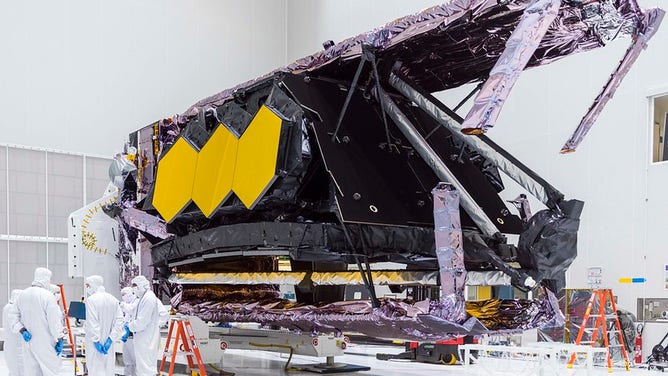NASA moves ahead with James Webb Space Telescope launch after more testing
Webb to launch on Dec. 22 at 7:20 a.m. ET

The James Webb Space Telescope inside the cleanroom at its launch site at Guiana Space Center, in French Guiana. (Image credit: NASA/Chris Gunn)
(NASA)
NASA's James Webb Space Telescope will still launch this year the space agency following an investigation into an incident that caused the observatory to shake.
The massive space telescope made the 5,800-mile journey from California to the launch facility in French Guiana by ship in mid-October. It was a carefully planned voyage that took years of planning. Since arriving at the port in Kourou engineers unloaded the observatory and begin checking it made the trip without damage.
Previously, the telescope was slated to liftoff on an Arianespace Ariane 5 rocket on Dec. 18, but recently the space agency announced the launch is now scheduled for Dec. 22 at 7:20 a.m. ET. The date change happened after a clamp securing the telescope unexpectedly released causing the observatory to vibrate.
According to NASA, technicians were preparing to attach Webb to the launch vehicle adapter, which is how the observatory is mated with the upper stage of the Ariane 5 rocket when "a sudden, unplanned release of a clamp band – which secures Webb to the launch vehicle adapter – caused a vibration throughout the observatory."
MORE: How to move a $10 billion space telescope 5,800 miles, avoid pirates and see back into the cosmos
A NASA spokesperson said the incident happened on Nov. 9 and an anomaly review board determined on Nov. 20 that additional testing was needed. The launch date was moved to allow for this testing, the spokesperson said.
A NASA-led review of the incident was completed and teams have determined no observatory pieces were damaged.
The space agency gave the approval to begin fueling Webb on Nov. 25. The process is expected to take about ten days.
The 29-foot-tall observatory was built in the U.S. and underwent years of tests to prepare for the intensity of a rocket launch. The observatory has 18-gold plated mirrors and a sun shield about the size of a tennis court.
Webb is a partnership observatory between NASA, the Canadian and European space agencies. It follows in the footsteps of the Hubble Space Telescope, but the two are unique. Webb will look at the Universe in the infrared, whereas Hubble uses optical and ultraviolet. Hubble's successor, once in space, will be much further from Earth, about 1.5 million kilometers.
Webb will be able to see farther back into the cosmos, observing the first "baby" galaxies.